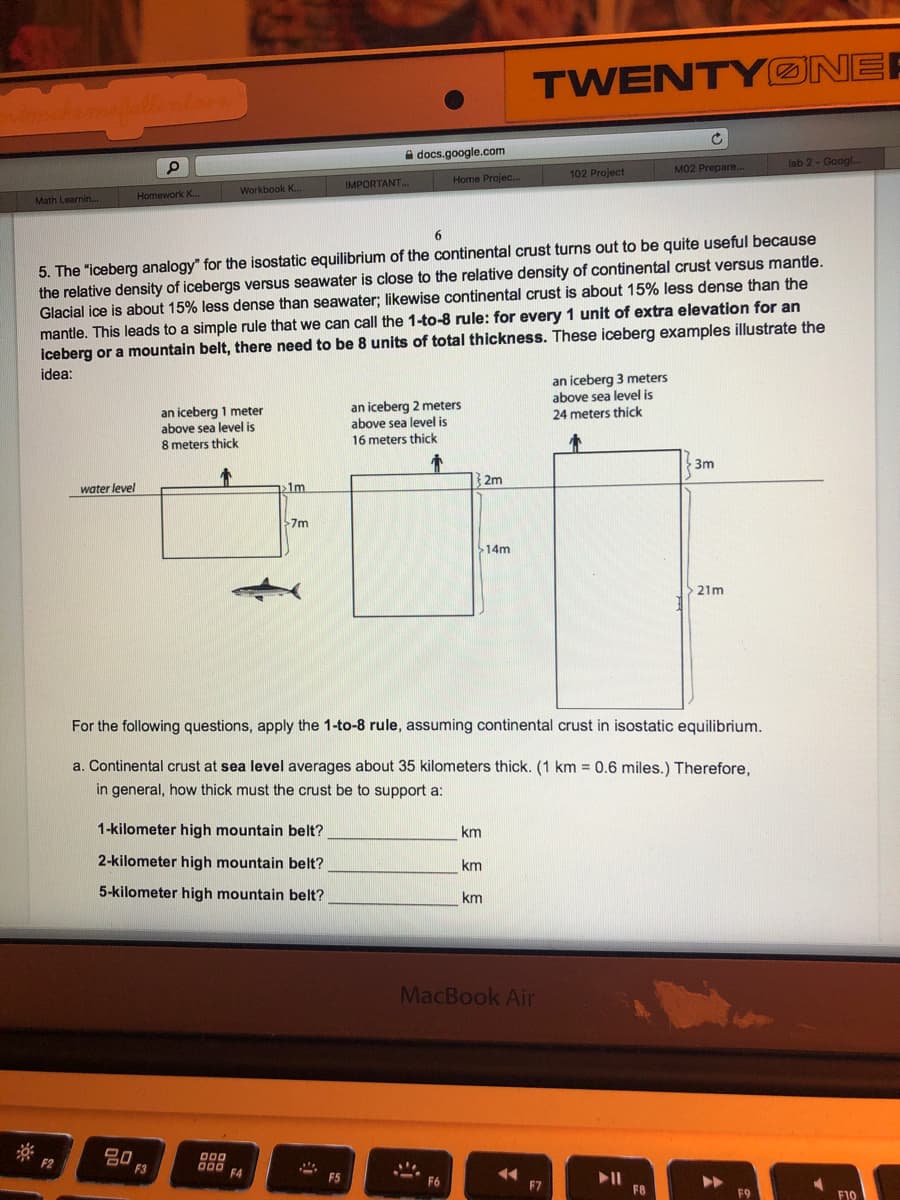5. The "iceberg analogy" for the isostatic equilibrium of the continental crust turns out to be quite the relative density of icebergs versus seawater is close to the relative density of continental crust versus mantle. Glacial ice is about 15% less dense than seawater; likewise continental crust is about 15% less dense than the mantle. This leads to a simple rule that we can call the 1-to-8 rule: for every 1 unit of extra elevation for an iceberg or a mountain belt, there need to be 8 units of total thickness. These iceberg examples illustrate the idea: an iceberg 3 meters above sea level is 24 meters thick an iceberg 1 meter above sea level is 8 meters thick an iceberg 2 meters above sea level is 16 meters thick 3m 2m water level 1m >7m 14m 21m For the following questions, apply the 1-to-8 rule, assuming continental crust in isostatic equilibrium. a. Continental crust at sea level averages about 35 kilometers thick. (1 km = 0.6 miles.) Therefore, in general, how thick must the crust be to support a: 1-kilometer high mountain belt? km 2-kilometer high mountain belt? km 5-kilometer high mountain belt? km
5. The "iceberg analogy" for the isostatic equilibrium of the continental crust turns out to be quite the relative density of icebergs versus seawater is close to the relative density of continental crust versus mantle. Glacial ice is about 15% less dense than seawater; likewise continental crust is about 15% less dense than the mantle. This leads to a simple rule that we can call the 1-to-8 rule: for every 1 unit of extra elevation for an iceberg or a mountain belt, there need to be 8 units of total thickness. These iceberg examples illustrate the idea: an iceberg 3 meters above sea level is 24 meters thick an iceberg 1 meter above sea level is 8 meters thick an iceberg 2 meters above sea level is 16 meters thick 3m 2m water level 1m >7m 14m 21m For the following questions, apply the 1-to-8 rule, assuming continental crust in isostatic equilibrium. a. Continental crust at sea level averages about 35 kilometers thick. (1 km = 0.6 miles.) Therefore, in general, how thick must the crust be to support a: 1-kilometer high mountain belt? km 2-kilometer high mountain belt? km 5-kilometer high mountain belt? km
Related questions
Question

Transcribed Image Text:5. The "iceberg analogy" for the isostatic equilibrium of the continental crust turns out to be quite
the relative density of icebergs versus seawater is close to the relative density of continental crust versus mantle.
Glacial ice is about 15% less dense than seawater; likewise continental crust is about 15% less dense than the
mantle. This leads to a simple rule that we can call the 1-to-8 rule: for every 1 unit of extra elevation for an
iceberg or a mountain belt, there need to be 8 units of total thickness. These iceberg examples illustrate the
idea:
an iceberg 3 meters
above sea level is
24 meters thick
an iceberg 1 meter
above sea level is
8 meters thick
an iceberg 2 meters
above sea level is
16 meters thick
3m
2m
water level
1m
>7m
14m
21m
For the following questions, apply the 1-to-8 rule, assuming continental crust in isostatic equilibrium.
a. Continental crust at sea level averages about 35 kilometers thick. (1 km = 0.6 miles.) Therefore,
in general, how thick must the crust be to support a:
1-kilometer high mountain belt?
km
2-kilometer high mountain belt?
km
5-kilometer high mountain belt?
km
Expert Solution
This question has been solved!
Explore an expertly crafted, step-by-step solution for a thorough understanding of key concepts.
This is a popular solution!
Trending now
This is a popular solution!
Step by step
Solved in 2 steps with 2 images
